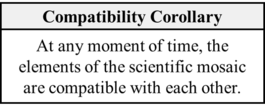Compatibility of Mosaic Elements
Are all elements within a mosaic compatible with one another?
Is it possible for two incompatible elements to be part of the same mosaic, or are the elements of any given mosaic always compatible with one another?
In the scientonomic context, this question was first formulated by Patrick Fraser and Ameer Sarwar in 2018. The question is currently accepted as a legitimate topic for discussion by Scientonomy community.
In Scientonomy, the accepted answer to the question is:
- At any moment of time, the elements of the scientific mosaic are compatible with each other.
Contents
Scientonomic History
Acceptance Record of the Question
| Community | Accepted From | Acceptance Indicators | Still Accepted | Accepted Until | Rejection Indicators |
|---|---|---|---|---|---|
| Scientonomy | 28 December 2018 | The question became accepted with the publication of the paper by Fraser & Sarwar. | Yes |
All Direct Answers
| Theory | Formulation | Formulated In |
|---|---|---|
| Compatibility Corollary (Fraser-Sarwar-2018) | At any moment of time, the elements of the scientific mosaic are compatible with each other. | 2018 |
If a direct answer to this question is missing, please click here to add it.
Accepted Direct Answers
| Community | Theory | Formulation | Accepted From | Accepted Until |
|---|---|---|---|---|
| Scientonomy | Compatibility Corollary (Fraser-Sarwar-2018) | At any moment of time, the elements of the scientific mosaic are compatible with each other. | 3 June 2020 |
Suggested Modifications
| Modification | Community | Date Suggested | Summary | Date Assessed | Verdict | Verdict Rationale |
|---|---|---|---|---|---|---|
| Sciento-2018-0015 | Scientonomy | 28 December 2018 | Accept the definition of compatibility, as the ability of two elements to coexist in the same mosaic. Also replace the zeroth law with the compatibility corollary. | 3 June 2020 | Accepted | While the modification induced a few comments on the encyclopedia, it became accepted as a result of discussions that took place mostly offline. It was agreed that the modification "comes to remedy one of the glaring omissions" in the current zeroth which doesn't "say much above and beyond what is already implicit in the notion of compatibility"c1 as it "is lacking in empirical content, and should be replaced with a definition of compatibility".c2 It was also noted that the proposed "definition of compatibility criteria... captures the gist of the concept as it has been used in our community".c3 It was also agreed that "the compatibility corollary follows from this definition".c4 c5 Finally, the community accepted that the definition and the corollary "recover the content of the Zeroth Law".c6 |
Current View
In Scientonomy, the accepted answer to the question is Compatibility Corollary (Fraser-Sarwar-2018).
Compatibility Corollary (Fraser-Sarwar-2018) states: "At any moment of time, the elements of the scientific mosaic are compatible with each other."
The corollary is meant to restate the content of Harder's the zeroth law of scientific change. Since the corollary follows deductively from the definition of compatibility, it highlights that the zeroth law as it was formulated by Harder is tautologous. Since the corollary covers the same idea as the zeroth law, all the theorems that were thought to be deducible by means of the zeroth law (e.g. the theory rejection theorem or the method rejection theorem) can now be considered deducible by means of the corollary.
Related Topics
This question is a subquestion of Mechanism of Compatibility.
